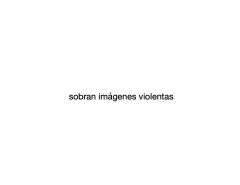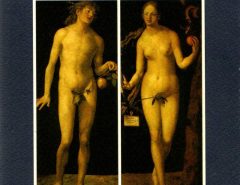Mientras trabajábamos en la exposición, nos encontramos fascinados por un nuevo tema, el de la migración de las formas. Como un movimiento detectable de la forma de un lugar a otro a través de la geografía, del tiempo y de los media. Así es como Ruth Noack y Roger Buergel, comisarios de la Documenta 12, definen un tema constante en la historiografía del arte del siglo XX. Formas viajeras, reaparición de viejos temas en culturas distantes, influencias inesperadas, permanencia de imágenes y símbolos en diferentes religiones son ideas fundamentales en historiadores del arte tan diferentes como Josef Strzygowski, el historiador vienés que defendía los orígenes de la cultura occidental en el oriente místico, sin relación con el ámbito latino, y Aby Warburg, el archivista que rastreaba los rasgos de la superviviencia de la antigüedad en nuestra cultura de masas. Tráfico y circulación de imágenes, motivos y técnicas que aluden a la permanencia y transformación de ideologías en diferentes individuos, espacios y tiempo.
No hace mucho, tuvimos la ocasión de comprobar este carácter viajero de las imágenes, en un breve intercambio de ideas con el artista taiwanés Chen Chieh Jen, artista que estuvo presente en Geopoéticas, sobre Lingchi (2002), uno de sus primeros trabajos en 16 mm.

Se trata de una video-instalación de tres canales que escenifica la reinterpretación histórica de un documento fotográfico, el que recoge un episodio de la célebre tortura conocida como la «muerte de los 1000 cortes». El lingchi consistía en el desmembramiento gradual del reo, que concluía con una puñalada al corazón o decapitamiento, durante una hora aproximadamente, aplicado, en ciertas ocasiones, a la persona viva; en otras, a la persona muerta como forma de humillación. A ojos occidentales fue interpretado como un castigo de extrema crueldad, derivando de esta severa acción la referencia de tortura china a un extremo sufriemiento en occidente. Sin embargo, investigadores como Jerome Bourgon defienden que lo que repelía al espectador occidental no era la crueldad, sino el desapasionamiento y carencia de soporte religioso con el que se desarrollaba el castigo.

El mismo documento histórico que sirvió de punto de partida para el Lingchi de Chen Chieh Jen obsesionó a Georges Bataille hasta el punto de volver una y otra vez a la ligera sonrisa del rostro del ajusticiado como prueba de que el éxtasis procede de un horror extremo. La religión no puede, escribe Bataille, existir sin el sacrificio. Bataille conservó la foto durante todo su vida, e incluso concluyó con ella Las Lágrimas de Eros: El mundo vinculado a la imagen expuesta de la víctima fotografiada ante el suplicio, y repetidas veces, en Pekín, es, que yo sepa, el más angustioso de los que nos son accesibles a través de las imágenes fijadas por la luz (...). Nunca he dejado de estar obsesionado por esta imagen del dolor, estática, a la vez que intolerable.

Esta misma imagen de Lingchi fascinó al pintor Gutiérrez Solana, quien, con alusiones al martirologio cristiano y al ajusticiamiento de un revolucionario, la copió en un cuadro que hoy se conserva en una colección privada de Madrid.
Sobre este viaje de la imagen, conversamos con Chen:

P:
In your work, the relationship between photography and cinema is very important. The theorist Roland Barthes wrote: «the photographer repeats mechanically what cannot be repeated existentially». Lingchi, being the repetition of a historical photography, contradicts this assertion.
Could you please elaborate a bit more on the relation between the photographic and the cinematic that appears in such work?
I mean, is in Lingchi the photograph the original document of truth or, on the contrary, is the image in movement a way to interrogate the truth that we assume in photography?
R:
The question with which I am concerned is not whether a photograph is the original document of truth. I am concerned with how it is interpreted. I am sure that the photograph of lingchi execution is a partial document of truth. The point is that over a long period of time, the Chinese society, law, people and so forth that were captured in the lingchi execution have been simplified. After this famous photograph was taken in 1904 (or 1905), it incited different reactions in the West during different periods of history. But up until I began to attempt to discuss this photograph in 1996, no Chinese person was ever invited to express his or her thoughts or opinions on it.
When we examine the long history of photography, we can discover that people in marginal areas frequently can only play the role of a silent photographee. They can only be interpreted, but they cannot express their own voice. Thus, the photographee becomes the silent Other.
When a photograph becomes merely a one-way interpretive object that belongs to the society of the photographer, the photograph loses the potential for a two-way dialogue. What interests me is how to liberate the personal rights of interpretation for the people who were photographed in this picture, and allow the fixed definition of the photo to return to the multiple meanings and complex aspects that exist in a photograph.
P:
Talking about Linghchi, we may mention the perception of the Other that this work deals with. Since the historian Edward Said we are aware of the «orientalism», the imaginary perception of the Other, invented by the Westerners. However, «orientalism» is a field of study focused in Near and Middle East and ignores Far East. Hence, we have not identified yet the stereotypes of the Far East in the Western world.
Lingchi seems to speak about one of these: the Chinese torture mistakenly perceived as an extreme cruelty by visitors and theoreticians alike (George Bataille, for example).Could you please elaborate more on how this contradictions and
stereotypes are presented in Lingchi?
Lingchi also offers a reflection on transgression and sadism. This is a poetic of cruelty that you did explore in your early photography, but seems to be abandoned now. However, and also thinking about the meaning of Lingchi in Chinese language (as a slow suffering), may way understand your videoworks (such as Bade Area, On Going or The Route) as a contemporary lingchi?
R:
As I was reading Saids Orientalism, my understanding was not merely what was raised in the book: Orientalism is a set system of knowledge about the East that was constructed in the West with the purpose of controlling and ruling the East. I think that the construction of these imaginary perceptions of The Other eventually further develops into a set system of knowledge representing The Other, and this power manipulation used to normalize The Other is seen in all societies today. For example, in Taiwan this model has reappeared in the form of the disadvantageous position of Southeast Asian laborers. So what we should really reflect on is not just the power relationship between the West and the East but all forms of power manipulation similar to that depicted in Orientalism.
As regards your query about the Western worlds stereotypes about the Far East, I think that in addition to traditional prior impressions of the East as being full of mystery and exoticism, impressions of China in the recent modern era cannot get away from the communist revolution of 1949, the Cultural Revolution, the Tiananmen Square massacre, the world factory and the notion the China is set to become the worlds single largest economic entity. As for Taiwan, I think most peoples perception is somewhat hazy and dont consider it a terribly important place.
In Lingchi my intent was indeed to discuss the issue of stereotypes. In addition to my previous comments where I sought to use this photograph to prompt renewed debate over the issue of the right of interpretation, I would like to add that as far as the photo often being seen in the West as a kind of Eastern version of the imagery of Christ’s suffering, I cite the story of the past life of the Buddha, in which he is subject to lingchi, to provide a different version as regards the point of view of the victims body. In the version involving the Buddha, the victims body becomes a kind of conduit leading to the past and the future. In the film this led me to transform the wounds of the victim into a kind of conduit through which we may view our modern history. Through this conduit we can see that all manner of formless lingchi tortures continue to this day. At the same time we cannot simply focus on the aspect of the poetics of cruelty to aestheticize the photo while dodging the fact that it reflects the oppressive relationship within a multi-layered power structure. In the photo, the Western photographer and the symbolic emperors hua gai (the official in charge of execution of sentence ordinarily sat beneath a large parasol, symbolizing imperial rule, known as a hua gai), which do not appear in the original, are depicted together on the execution ground. My meaning was to convey the idea that this is an extremely complex image, combining the exercise of authority in the feudal era, colonialism, technological hegemony, Eastern and Western body concepts, the ethics of spectating and the extended significance of this word lingchi in the contemporary era. I feel that the issue of stereotypes does not merely hinge on whether or not they are appropriate or whether they are based in fact but in the oversimplification of the interpretation of the perceptions and factual basis behind them.
In my early digitally altered images I did indeed explore the issues of the poetics of cruelty. But there was another facet to these digitally altered images. During Taiwans martial law era, all primary and middle schools would periodically exhibit horrifying images from tragic events such as the Rape of Nanking and the struggle sessions of the Cultural Revolution. The purpose of these photo exhibits was to trumpet the legitimacy of KMT rule and circulate anti-communist propaganda but it was also an era where the vast majority of the people had no access to a camera and these were my first experience with viewing photographs. Mt relationship with photography began with these images of cruelty. This later prompted me to ponder the relationship between photography and power and to explore the ideology such images sought to project.
I ponder my experiences of growing up and the reality of Taiwan society to develop my work. As I was shooting Lingchi I by chance got to know the unemployed women I later filmed in Factory. Their experience called to mind for me the memories of Taiwans manufacturing history over the past 30 years and gave me the feeling that lingchi had not quite ended. My later works can certainly be interpreted as an exploration of the various contemporary faces of lingchi.



Hi
Inside Line: We test everything from the locking differential to the iPod input on the updated Toyota FJ Cruiser to see how it will fare in the 21st century.
toyota fj cruiser
Bye